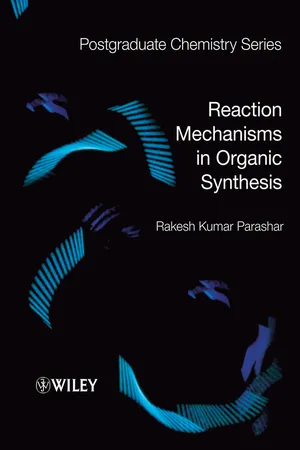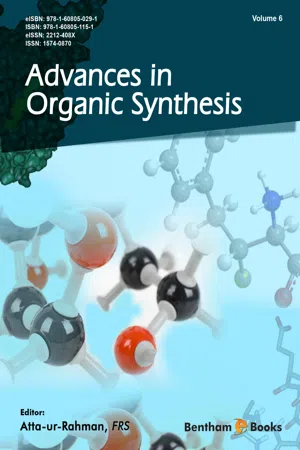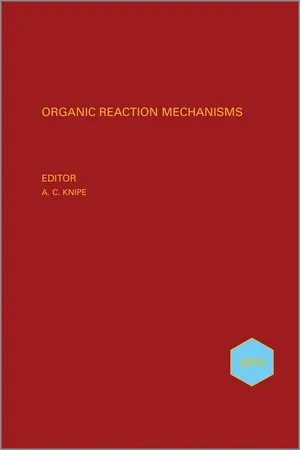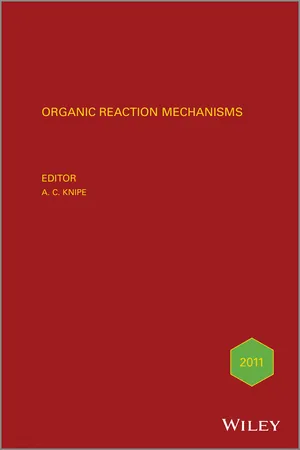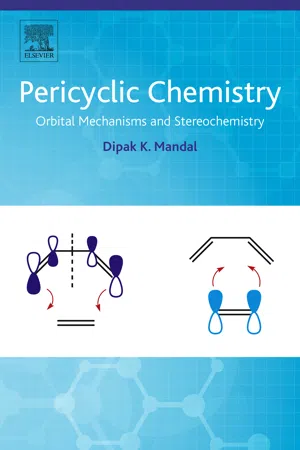Chemistry
8 + 2 Cycloaddition
8 + 2 Cycloaddition is a chemical reaction that involves the formation of a new ring by the reaction of eight π-electrons and two π-electrons. This reaction is also known as the "octet rule" and is commonly used in organic synthesis to create complex molecules. The reaction is highly selective and can be used to create a wide range of different compounds.
Written by Perlego with AI-assistance
Related key terms
Related key terms
1 of 4
Related key terms
1 of 3
7 Key excerpts on "8 + 2 Cycloaddition"
- eBook - ePub
- Roderick Bates(Author)
- 2012(Publication Date)
- Wiley(Publisher)
11 Cycloaddition and Cycloisomerization ReactionsCycloaddition reactions are of enormous importance in organic synthesis, but they are necessarily limited by the Woodward–Hoffman rules. The majority of cycloaddition reactions used in organic synthesis form six-membered ring carbocycles through the Diels–Alder reaction. Some four-membered rings can be formed, and a range of five-membered ring heterocycles can be formed by 1,3-dipolar cycloadditions. The use of transition metals can not only facilitate the formation of these “convenient” ring sizes, but also permit the formation of other ring sizes.1 In addition, conventional cycloadditions almost always involve the adding together of two components, such as a diene and a dienophile, while transition metals can allow three separate components to be brought together. The participation of the transition metal means that all of these reactions become formal cycloadditions, and have multi-step mechanisms.11.1 Formal Six-Electron, Six-Atom Cycloadditions 11.1.1 The [4 + 2] CycloadditionThe Diels–Alder reaction is a cornerstone of organic synthesis, but it has its limitations. Principal among these is that diene/alkene pairs without suitable electronic activation react very slowly, if at all. Usually, an electron-poor alkene is employed. Enormous rate accelerations can be achieved with Lewis-acid catalysis. This form of catalysis requires that the substrate possesses a group conjugated to the alkene that is capable of coordination to the Lewis acid. An alternative means of catalysis is to use a transition metal, which works by coordinating directly to the π-systems, bringing them together and forming the bonds one by one.An effective catalyst for this reaction with diene–ynes and diene-allenes2 is Ni(COD)2 with added phosphite ligands. This can result in a reduction of the temperature required for the reaction from 160 °C to room temperature (Schemes 11.1 and 11.2 ).3 Other catalysts, such as rhodium complexes,4 have also been used (Schemes 11.2 and 11.3 ). The use of chiral ligands allows asymmetric cycloadditions (Schemes 11.4 and 11.5 ).5,6 - eBook - ePub
- Rakesh Kumar Parashar(Author)
- 2013(Publication Date)
- Wiley-Blackwell(Publisher)
Fig. 8.19 ).Figure 8.198.3.2 [2+2]-Cycloaddition reactions
Dimerization of ethene to cyclobutane, described as a [2+2]-cycloaddition reaction, does not proceed in either the forward or reverse directions under thermal conditions. But the [2+2]-cycloaddition reaction does occur under photochemical conditions. For example, ethene and maleic anhydride when exposed to UV light at −65°C gave cyclobutane diacid anhydride (8.11) in 77% yield.8.3.3 1,3-Dipolar additions
[4s +2s ]-Cycloaddition reactions leading to five-membered heterocyclic adducts are classified as dipolar cycloadditions22,23 . 1,3-Dipolar cycloaddition involves two components just like the Diels-Alder reaction, one dipolar heteroatom compound analogous to diene and the other dipolarophile analogous to dienophile. The dipolar heteroatom compound (1,3-dipole) may be exemplified by ozone and diazomethane.8.3.4 Theoretical explanation
Cycloaddition reactions can be explained in terms of the π-MOs of the reactants.Correlation diagram
Cycloaddition reactions can be explained by using correlation diagrams. According to the orbital symmetry theory, the symmetry of the orbitals of the reactants must be conserved as they are transformed into the orbitals of the product.Consider a simple example of a cycloaddition reaction of two molecules of ethene to form cyclobutane. Let us classify all the MOs of reactants and the product as symmetric (S) or antisymmetric (A) with respect to symmetry planes m and C 2 . Once these symmetries are noted, correlations of reactants and product orbitals may be drawn so that orbitals of like symmetry are connected. It is assumed that ethene molecules attack each other in parallel planes (i.e. vertically). There are two symmetry planes (the mirror planes), one bisecting the π-system of the molecules (plane 1, vertical) and the other between the interacting molecules (plane 2, horizontal), as shown in Fig. 8.20 - eBook - ePub
- Atta-ur-Rahman(Author)
- 0(Publication Date)
- Bentham Science Publishers(Publisher)
1.. INTRODUCTIONCycloaddition reactions are among the most powerful and most frequently used methods for the construction of rings [1 ]. Cycloadditions can be carried out using heat, light, or Lewis acids. However, these promoters usually require the presence of polar functional groups in the substrates, and extreme conditions (high temperature and high pressure) are usually required for unactivated substrates. Transition metal catalysts provide a new avenue to promote cycloadditions of unactivated substrates and cycloadditions that are theoretically forbidden or difficult to achieve. Transition metal-catalyzed cycloadditions have demonstratedtheir usefulness in the formation of rings and complex molecules [2 ]. The use of transition metal catalysts provide new opportunities for highly selective cycloaddition reactions since complexation of the metal to an unactivated alkene, alkyne, or diene significantly modifies the reactivity of this moiety, opening the way for enhanced reactivity and novel reactions. Recent developments in transition metal-catalyzed [2+2+1], [4+2], [5+2], [4+4], and [6+2] cycloaddition reactions [3 ] have provided efficient methods for the construction of 5- to 8-membered rings. This review focuses on the development of transition metal-catalyzed [2+2] cycloadditions between bicyclic alkenes and alkynes for the construction of cyclobutene rings.2.. TRANSITION METAL-CATALYZED CYCLOADDITIONS OF BICYCLO[2.2.1]HEPTA-2,5-DIENE
There have been numerous transition metal-catalyzed cycloadditions developed for bicyclo[2.2.1]hepta-2,5-diene (commonly known as norbornadiene, NBD) and some selected examples are shown in Scheme 1 . These cycloadditions can be divided into two main types: (i) cycloadditions involving only one of the two double bonds of NBD (paths (a)-(e) in Scheme 1 ) [4 ], and (ii) cycloadditions involving both double bonds of NBD (paths (f)-(j) in Scheme 1 ) [4a , 5 - eBook - ePub
Organic Reaction Mechanisms 2010
An annual survey covering the literature dated January to December 2010
- A. C. Knipe, A. C. Knipe(Authors)
- 2012(Publication Date)
- Wiley(Publisher)
72 + 2-Cycloaddition
Recent developments in the inter- and intra-molecular 2 + 2-cycloadditions of allenes with alkenes and alkynes have been critically reviewed.8Ru(bpy)3 2+ has been shown to be an effective photocatalyst for the 2 + 2-cycloaddition of electron-rich alkenes (9) to form cyclobutanes (10) (Scheme 3 ).9 The HCl-catalysed photodimerization of (Z)-4-styrylpyridine produced cis–cis–trans-dimers through a cation–π interaction.10Scheme 3The iridium-catalysed enantioselective 2 + 2-cycloaddition of oxabicyclo alkenes (11) with terminal alkynes yielded cyclobutenes (12) in a single step with excellent enantioselectivity (94–99% ee) (Scheme 4 ).11 In the absence of light and catalyst, halogenated trifluoroacetylacetylenes undergo formally forbidden 2 + 2-cycloaddition with non-activated alkenes.12 The 2 + 2-cycloaddition of siloxy(trialkoxy)ethene to ynones and ynoates formed cyclobutene derivatives with high regioselectivity.13 - eBook - ePub
Organic Reaction Mechanisms 2011
An annual survey covering the literature dated January to December 2011
- A. C. Knipe, A. C. Knipe(Authors)
- 2014(Publication Date)
- Wiley(Publisher)
Chapter 12 Addition Reactions: Cycloaddition N. Dennis3 Camphor Laurel Court, Stretton, Queensland Australia- 2 + 2-Cycloaddition
- 2 + 3-Cycloaddition
- 2 + 4-Cycloaddition
- Miscellaneous
- References
The enantioselective N-heterocyclic carbene-catalysed formal 2 + 2- and 2 + 2 + 2-cycloadditions of ketenes with isothiocyanates have been investigated. At room temperature, the reaction of N-arylthiocyanates favours the 2 + 2-cycloaddition. However, at −40 °C, N-benzoylisothiocyanates undergo the 2 + 2 + 2-cycloaddition.1The cationic, gold(I)-catalysed tandem heterocyclization/3 + 2-cycloaddition of 2-(1-alkynyl)-2-alken-1-ones (1) with 3-styrylindoles (2) yielded highly substituted cyclopenta[c]furans (3) in a one-pot reaction under mild conditions. The expected cyclohepta[c]furans (4) were not isolated (Scheme 1 ).2 The 1,3-dipolar cycloaddition of 3-oxidopyridinium betaines with pentafulvenes produced a variety of bicyclo[6.3.0]undecanes and bicyclo[5.3.0]decanes via 3 + 2- and 6 + 3-cycloadditions.3Scheme 1The photocycloadditions of 2,3-dimethyl-1,3-diene with 4-(alk-1-ynyl)-substituted coumarins (5) produced a mixture of 4 + 2- and 4 + 4-cycloadducts (6) and (7), respectively. However, the corresponding thiocoumarins (8) yielded a single 4 + 2-cycloadduct (9) (Scheme 2 ).4 The intramolecular photocycloadditions (>290 nm) of 1,3-enynes with 2-pyridone yielded 2 + 2- and 4 + 4-cycloadducts.5 The Rh(I)-catalysed formal 5 + 1-/2 + 2 + 2-cycloaddition of 1-yne-vinylcyclopropanes (10) with two carbon monoxide units produced multifunctional angular tricyclic 5/5/6 compounds (11) in a one-step mechanism (Scheme 3 ).6 - eBook - ePub
Small Molecule Drug Discovery
Methods, Molecules and Applications
- Andrea Trabocchi, Elena Lenci(Authors)
- 2019(Publication Date)
- Elsevier(Publisher)
4 Cl, 80°C, then THF, CuI, DIPEA.Beside common [2+2], [4+2], and [3+2] cycloaddition strategies, an interesting approach that found application in natural product synthesis is the [5+2] cycloaddition [105] . Seven-membered rings are widely diffused among natural and drug products, and cycloadditions allow to generate complex and diverse scaffolds with ease with respect to a linear synthesis followed by ring closure. Several examples of metal-catalyzed or metal-free [5+2] cycloadditions are reported; also, enantioselective versions have been developed. Yudin and Wender reported several methods to achieve an effective divergent synthesis of seven-membered carbocycles starting from vinyl cyclopropanes 44 via a Rh-catalyzed [5+2] cycloaddition (Scheme 2.19 ). Compound 44 reacted smoothly with terminal and internal alkynes giving 4,5-disubstituted cyclohept-4-enones 45 [106] . Propargyltrimethylsilanes were employed as allenes equivalents giving the corresponding cycloheptanones 46 [107] ; ynol ethers as ketene equivalents are also feasible substrate for the reaction, leading to substituted 1,4-cycloheptandiones 47 [108] .Using chiral catalysts or ligands, cycloadditions can be performed in an enantio- and/or diastereoselective fashion. Configuring quaternary chiral centers is an utmost challenging task; nevertheless, Zhang et al. recently reported a regio- and enantioselective Cu-catalyzed 1,3-dipolar cycloaddition affording in high yields and enantiomeric excesses valuable pyrrolidines [109] . Recently, a similar approach toward the diversity-oriented synthesis of complex chromeno-pyrrolidines has also been reported [110] .Scheme 2.19 Scaffold-divergent synthesis via Rh-catalyzed [5+2] cycloadditions.Finally, Baran et al. proposed an interesting approach toward enantioselective diversity-oriented synthesis of drug-like molecules [111] . On one hand, cycloadditions feature an unmatched capability of building complex ring systems with great stereocontrol, forging several bonds simultaneously; however, they lack modularity. On the other hand, cross-couplings afford new C–C bond with excellent reliability and modularity. Baran developed a concise synthetic path exploiting the advantages of these two classes of transformations. They established a protocol consisting of cycloadditions and cross-coupling reactions, using commercial, cheap maleic anhydride as surrogate for a chiral di(pseudo)halide. Maleic anhydride undergoes a cycloaddition in the first step, giving a meso adduct that is subsequently desymmetrized. At last, a cross-coupling/deprotection/cross-coupling sequence on the chiral precursor leads to the final product with the desired stereochemistry. Different cross-coupling reactions (e.g., Kumada, Suzuki, Negishi) can be employed effectively, as well as several cycloaddition reactions ([4+2], [3+2], [2+2], [2+1]). As proof of the potential of their approach, they applied it simplifying the formal syntheses of known substances of interest, such as Asenapine 48 (Scheme 2.20 - eBook - ePub
Pericyclic Chemistry
Orbital Mechanisms and Stereochemistry
- Dipak Kumar Mandal(Author)
- 2018(Publication Date)
- Elsevier(Publisher)
Chapter 5Cycloadditions 2: Stereochemistry of [4 + 2] and [2 + 2] Cycloadditions
Abstract
This chapter describes the stereochemistry of cycloaddition reactions with respect to [4 + 2] and [2 + 2] cycloadditions. The [4 + 2] cycloadditions include Diels–Alder reactions, 1,3-dipolar cycloadditions and cycloadditions with cations and anions. The stereospecificity and stereoselectivity of Diels–Alder reactions have been described wherein the product stereochemistry has been delineated using simple mnemonics. The asymmetric Diels–Alder reactions involving chiral auxiliary and chiral catalyst strategies have been presented and a mnemonic has been devised to draw product stereochemistry. The important features of intramolecular Diels–Alder reactions and examples of photochemical Diels–Alder and thermal antara/antara cycloadditions are also included. The stereochemistry of 1,3-dipolar cycloadditions are described with respect to stereospecificity, stereoselectivity, intramolecularity and asymmetric approach. The [4 + 2] cycloadditions with allyl cations, pentadienyl cations and allyl anions are presented with their stereochemistry. The descriptions of stereochemistry of [2 + 2] cycloadditions include both photochemical and thermal cycloadditions. The [2 + 2] photocycloadditions of alkenes and alpha, beta-unsaturated carbonyl compounds are described. The [2 + 2] thermal cycloadditions include mainly ketene cycloadditions with reference to regioselectivity, stereospecificity, stereoselectivity and periselectivity, and a brief description of the cycloadditions of related systems such as isocyanates, vinyl cations and allenes. The cycloaddition of singlet vinyl carbenes and cycloaddition of transition metal alkylidene in alkene metathesis are also illustrated.
Index pages curate the most relevant extracts from our library of academic textbooks. They’ve been created using an in-house natural language model (NLM), each adding context and meaning to key research topics.
Explore more topic indexes
Explore more topic indexes
1 of 6
Explore more topic indexes
1 of 4

